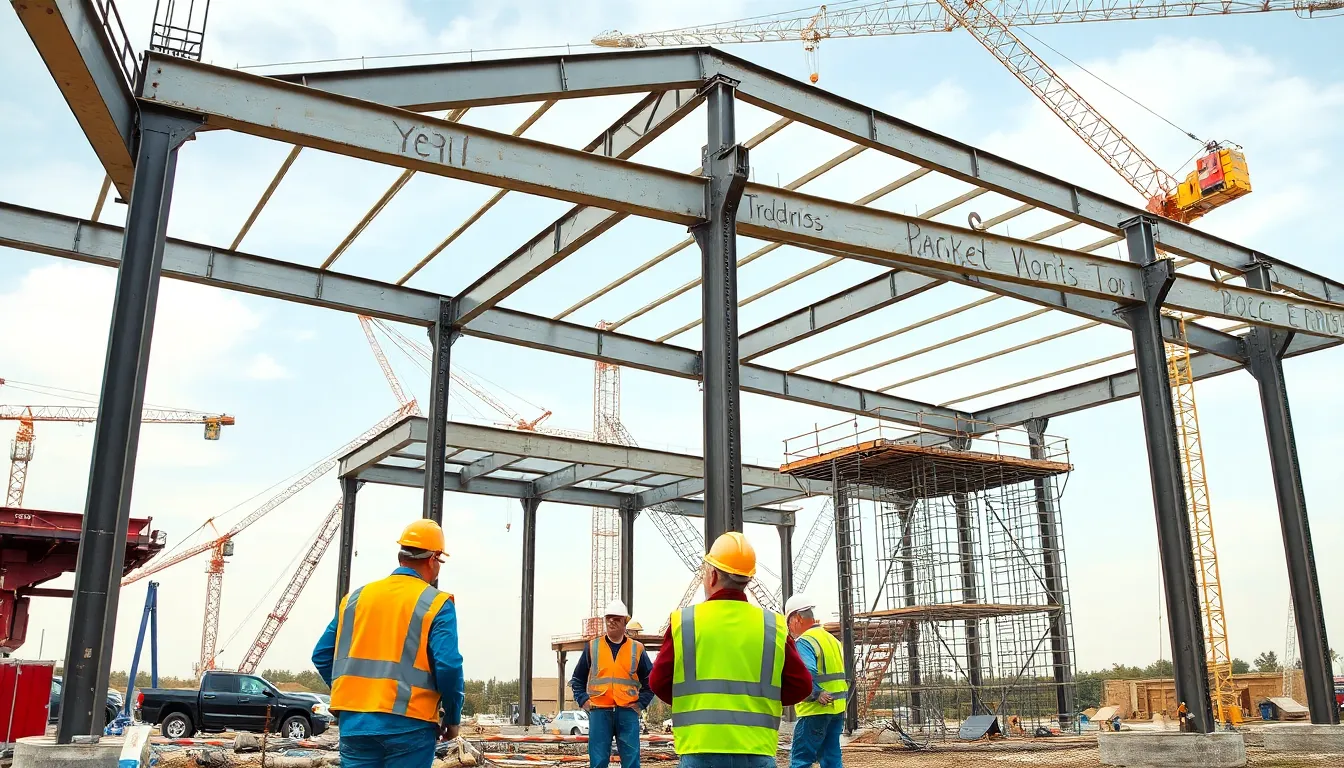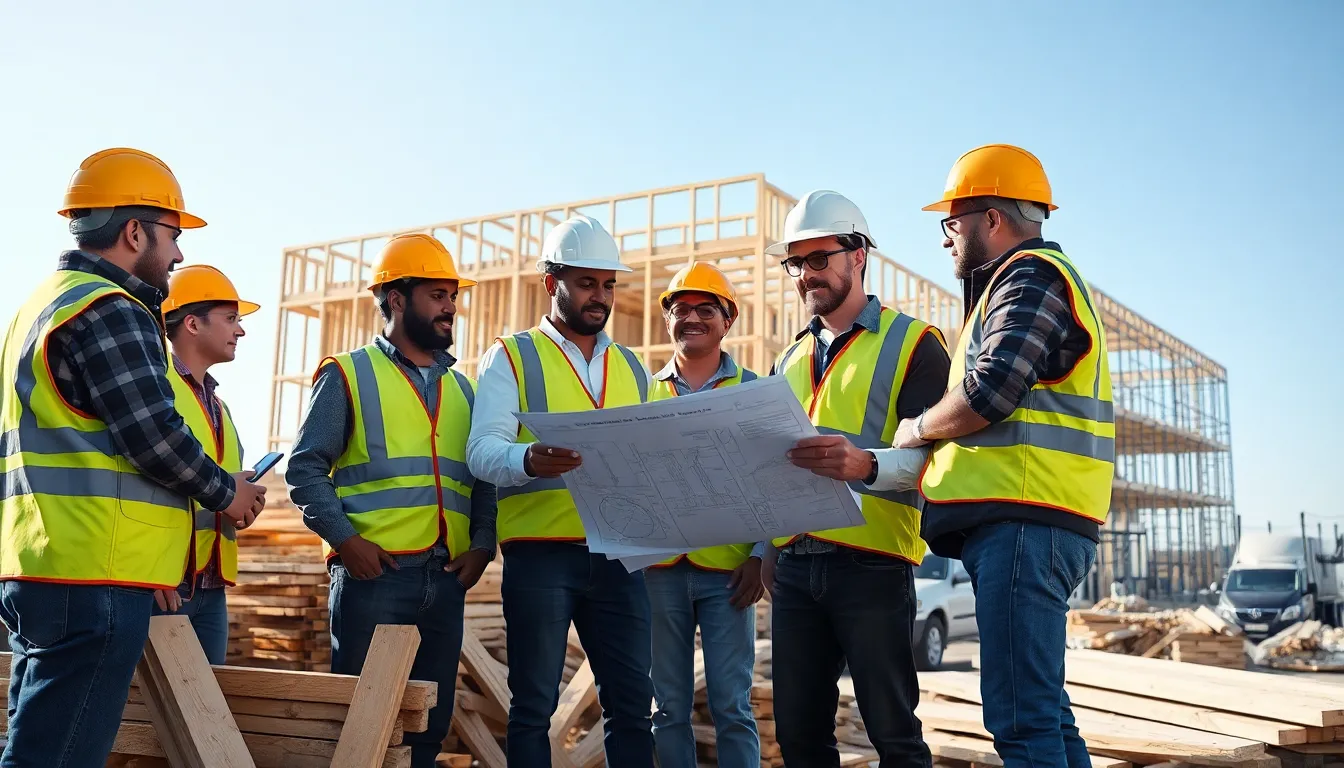Building a strong foundation isn’t just for relationships; it’s the cornerstone of construction too. Whether you’re dreaming of a cozy cottage or a towering skyscraper, understanding the fundamentals of building construction is essential. It’s like knowing the secret recipe for your grandma’s famous cookies—once you grasp the basics, you can whip up something amazing.
From the ground up, every nail, beam, and brick plays a vital role in creating structures that stand the test of time. Hefty jargon and complex blueprints might seem intimidating, but fear not! With a little guidance, anyone can learn the ropes of construction. So grab your hard hat and let’s dive into the world of building, where creativity meets engineering and every structure tells a story.
Table of Contents
ToggleOverview of Building Construction
Building construction involves a systematic approach that integrates engineering, architecture, and craftsmanship. Various stages exist within this process, each contributing to the final structure. Planning stands as the initial phase where architects create designs that meet both aesthetic and functional requirements.
Materials act as a foundation for construction. Concrete, steel, wood, and masonry serve unique purposes, offering distinct advantages. For instance, concrete provides durability while steel offers flexibility in design. Understanding the properties of these materials is vital for effective construction.
The next stage, site preparation, focuses on clearing the land and establishing a stable base. Proper grading and excavation prevent future structural issues. After site preparation, the construction of the foundational structure commences. Foundations—ranging from shallow to deep—support the entire building weight, ensuring stability.
Framing follows foundation work, forming the skeleton of the building. This phase utilizes beams, trusses, and walls to create a framework. Insulation and sheathing often accompany this step, enhancing energy efficiency and weather resistance.
In tandem with framing, various systems get installed. Electrical, plumbing, and HVAC systems are crucial for functionality. Ensuring compliance with building codes during this process guarantees safety and efficiency.
Finishing touches include installing windows, doors, and interior fixtures. These elements enhance livability while providing aesthetic appeal. Specific attention to detail during this phase can significantly impact the overall quality of the construction.
Ultimately, building construction weaves together multiple disciplines and trade skills. Each component, whether structural or aesthetic, plays a pivotal role in crafting durable and functional buildings.
Key Principles of Building Construction

Building construction relies on several key principles for success. Understanding these principles enhances the quality and durability of any structure.
Structural Integrity
Structural integrity is crucial for the stability of a building. Engineers assess load distribution to ensure that structures can bear weight and resist forces like wind and earthquakes. Safety standards and building codes guide this assessment, safeguarding occupants. The use of materials such as steel and reinforced concrete typically enhances strength and longevity. Additionally, regular inspections during construction help identify potential weaknesses early in the process. These actions collectively contribute to the overall safety and functionality of a building.
Material Selection
Material selection plays a vital role in building construction. The choice of materials directly affects not just aesthetics but also performance and durability. Common materials, such as concrete, steel, wood, and masonry, each offer unique benefits. For instance, concrete provides excellent compression strength while wood adds warmth and flexibility. Sustainability considerations often influence material choices, pushing for eco-friendly options. Combining different materials can maximize strengths while minimizing weaknesses, leading to cost-effective and resilient structures. In summary, thoughtful selection of materials lays the foundation for high-quality buildings.
Building Codes and Regulations
Building codes and regulations form a critical foundation in the construction process. They dictate safety, health, and general welfare standards for structures. Local authorities enforce these codes, ensuring compliance across communities.
Many aspects, such as structural integrity and fire safety, are covered by these guidelines. For example, codes specify minimum load requirements for beams, walls, and roofs, protecting against potential failure. Fire codes may require specific materials or designs to prevent the spread of flames during emergencies.
Particularly important is the International Building Code (IBC), which serves as a model for local regulations. This code promotes consistency across regions, allowing for safer construction practices. Not only does it cover safety, but it also addresses accessibility, ensuring structures accommodate individuals with disabilities.
Inspections play a vital role in ensuring compliance with building regulations. Inspectors assess various construction phases, from foundation work to final finishes. Non-compliance can lead to costly delays and necessitate rework, underlining the importance of adhering to these regulations.
Certification processes also help confirm that structures meet quality standards. Builders often seek certifications for energy efficiency, sustainability, and environmental impact, appealing to eco-conscious consumers.
Lastly, updates to building codes occur regularly to reflect advancements in technology and construction methods. Staying informed about these updates benefits it professionals and builders alike. Engaging with local agencies provides insights into the latest requirements.
Construction Techniques and Methods
Construction techniques and methods shape the way buildings come to life, utilizing both traditional and modern practices. Understanding these techniques ensures effective project execution and enhances structural integrity.
Traditional Methods
Traditional construction methods rely on time-tested practices and materials. Masonry, for example, involves bricks or stones bonded with mortar to create strong walls. Timber framing stands out as another method, where wooden beams provide support, often resulting in aesthetically pleasing structures. These conventional approaches often prioritize local materials and craftsmanship, promoting sustainability and community engagement. Many builders still favor these time-honored techniques due to their simplicity and reliability.
Modern Methods
Modern construction methods leverage technology and innovative materials to improve efficiency and performance. Prefabrication allows building components to be manufactured off-site before assembly on location, reducing construction time significantly. Advanced materials like engineered wood and structural steel enhance strength while minimizing weight. Concepts such as modular construction offer flexibility in design, allowing for quick adjustments and expansions. Techniques such as 3D printing are emerging, enabling intricate forms and improved resource management. Employing these modern methods optimizes construction processes and supports the creation of sustainable structures.
Sustainability in Building Construction
Sustainability plays a crucial role in modern building construction. Incorporating eco-friendly practices boosts energy efficiency while minimizing negative environmental impacts. Renewable resources, such as bamboo and recycled steel, serve as excellent materials in sustainable projects. Additionally, employing locally sourced materials reduces transportation emissions and supports regional economies.
Green building certifications, like LEED, encourage environmentally responsible design and construction methods. Builders aiming for LEED certification must follow specific guidelines, including energy-efficient systems and sustainable material choices. Incorporating natural light through large windows and skylights enhances energy savings and occupant well-being.
Efficient waste management strategies significantly contribute to sustainability. Reducing construction waste involves recycling materials like wood and metal, which lessens landfill contributions. Moreover, reusing existing structures instead of demolishing them conserves resources and preserves historical significance.
Energy-efficient systems, such as solar panels and geothermal heating, also enhance sustainability. Integrating these technologies reduces long-term operational costs and lowers carbon footprints. Furthermore, using smart building technologies optimizes energy consumption, responding automatically to changing conditions.
Water conservation systems, including rainwater harvesting and low-flow fixtures, are essential in sustainable building practices. These systems not only reduce water usage but also promote responsible resource management. Utilizing green roofs and permeable pavements can help manage stormwater runoff and improve urban biodiversity.
Sustainable landscaping contributes to the overall eco-friendliness of a construction project. Choosing native plants minimizes water needs while supporting local ecosystems. By prioritizing sustainability, builders create durable structures that benefit both occupants and the environment.
Mastering the fundamentals of building construction opens doors to a realm where creativity and engineering converge. By understanding the essential components and processes involved, individuals can appreciate the artistry behind each structure. The integration of sustainable practices ensures that future generations benefit from resilient and environmentally conscious designs.
With the right knowledge and tools, anyone can embark on their construction journey. Whether it’s grasping the significance of materials or navigating building codes, the path to becoming proficient in construction is accessible. Embracing these fundamentals not only leads to successful projects but also fosters a deeper connection to the built environment.






